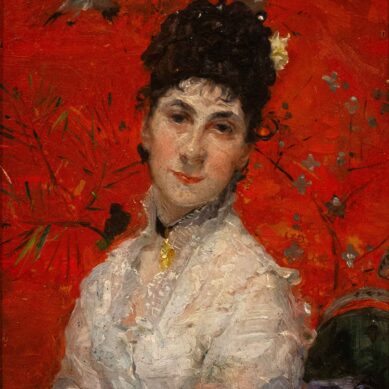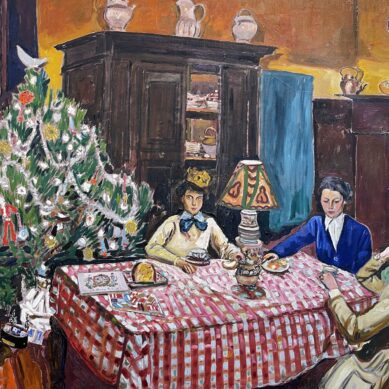With a selection of oil paintings and works on paper from institutions and prestigious private collections, the exhibition offers an exhaustive look at the artistic career of the Genoese Pietro Gaudenzi (1880-1955), one of the most appreciated painters of his time. From his formative years between La Spezia, Genoa and Rome to his retirement, in […]
April , 2024
Rovereto – Mart
14 April – 1 September 2024
From an idea by Vittorio Sgarbi.
Curated by Manuel Carrera and Alessandra Tiddia
April , 2024
Mario Cavaglieri (1887-1969).
Timeless Painter
April 2024
ENTER TO VIEW THE WORKS
February , 2024
Mark your calendars for TEFAF Maastricht, the world’s most important antique art fair returning March 9–14, 2024!
We look forward to welcoming you to this year’s extraordinary edition.
BERARDI GALLERIA D’ARTE
Stand 330
January , 2024
Costantino Barbella (1852-1925). The artist of feeling in search of truth
January 2024
ENTER TO VIEW THE WORKS Costantino Barbella, a Theatine sculptor, was the great storyteller of everyday life and popular epos in Abruzzo. His terracotta and bronze figures, rich in pathos and observed with fervent attention to the details of costumes and poses, appeared at the most important exhibitions of the second 19th century.
Timeless Painter
Manuel Barrese
Mario Cavaglieri was born in Rovigo in 1887 into a wealthy Jewish family. From 1900 to 1917 he lived in Padua, while staying in Bologna, Rome, Paris and Venice. He soon began exhibiting in Rome, at the exhibition of the local Società Amatori e Cultori (1907) and, in Venice, at the exhibitions of the ‘dissidents’ at Ca’ Pesaro (1909, 1910, 1912, 1913). From 1912 onwards he participated assiduously in the Venice Biennale (1914, 1920, 1922, 1924, 1938, 1948, 1950, 1957). In addition to appearing in the exhibitions of the Roman Secession, he also made a name for himself internationally by taking part in an exhibition in Munich in 1913 and in a group show in Zurich in 1918.
In 1919 he was the protagonist of a large exhibition in Rome, at the Casa d’Arte Cagiati, which attracted the curiosity of a young Roberto Longhi. The following year he exhibited at the Galleria Pesaro in Milan with a presentation by Vittorio Pica. From 1925 – having moved to France to the Gascon property of Peyloubére, in the Auch area – he frequently exhibited at the Salon d’Automne and the Salon des Indépendants.
Cavaglieri’s painting immediately amazes with its focus on a vivid chromatism that is connected to the noble Venetian tradition. His early training – which took place between Padua and Venice, first with Giovanni Vianello and later with Cesare Laurenti – was strongly influenced by the then pervasive climate of the Austrian-German secessions.
Although in his early trials he had already demonstrated a good awareness of the developments of Post-Impressionism, it was in 1911 – coinciding with a first founding stay in Paris – that Cavaglieri shifted the radius of his stylistic sympathies from Mitteleuropa to France. Grafting onto a pre-existing – and all-Klimtian – vocation for the visual saturation of the pictorial plane, Cavaglieri proved receptive to the formalisms popularised at the end of the 19th century first by the so-called Nabis and, in increasingly radical ways, by the Fauves. Thus, in the wake of Bonnard, Serusier, Vuillard and Matisse, the artist from Rovigo – until 1969, the year of his death – developed a poetic style that was at times intimist, at times aimed at celebrating the more affluent classes, declining it on the crest of two-dimensionality, on a taste for horror vacui and, above all, on that emphasis on colouristic data that would later lead a sharp critic like Maurizio Fagiolo dell’Arco to define Cavaglieri as the “Matisse of the Triveneto”.
In his textured painting stretched with vibrant additions, Cavaglieri lingered on describing an elegant upper-class civilisation immersed in environments characterised by rare and precious objects. Alongside portraits of his wife Giulietta – whom he married in 1921 and who immediately became his favourite model – Cavaglieri lingered in the description of sumptuous furnishings such as fabrics, tapestries, porcelain and chandeliers. It is no coincidence that the authoritative Roberto Longhi, already in 1919, claimed that each of the artist’s paintings appeared ‘rich, singing and unrestrained just like a real shawl, a gaudy carpet’.
As a cantor of a rarefied – and on closer inspection somewhat decaying – aristocratic world characterised by slightly démodé objects, the writer Giorgio Bassani, in an unsurpassed article that appeared in Longhi’s magazine “Paragone” in 1953, referred to Cavaglieri as a “painter of tender archaeologies of the past”.
Cavaglieri’s inspired, but never anecdotal and banal naturalism fascinated some of the most influential Italian art historians of the 20th century, for example Longhi and Carlo Ludovico Ragghianti. It was the latter who, in 1953, dedicated a large solo exhibition to him at the Strozzina in Florence with a presentation by Giuseppe Raimondi. Again under Ragghianti’s auspices, Cavaglieri was then brought to the attention of critics and the public in the important exhibition reviewing Modern Art in Italy 1915-1935, organised at Palazzo Strozzi in Florence (1967).
Manuel Barrese















